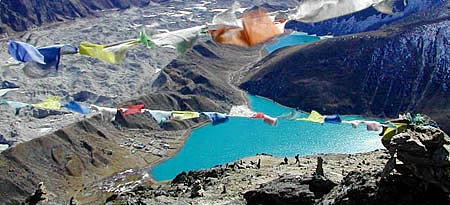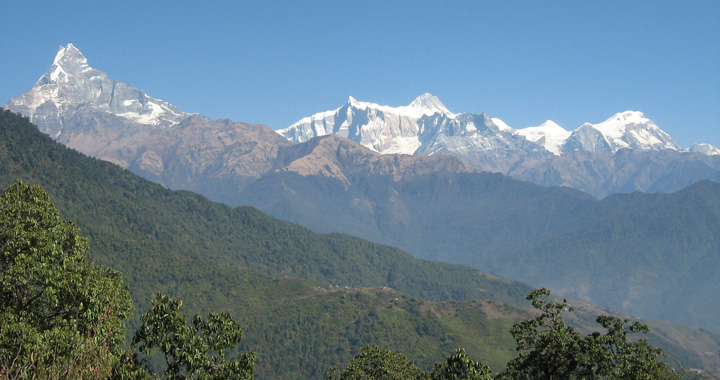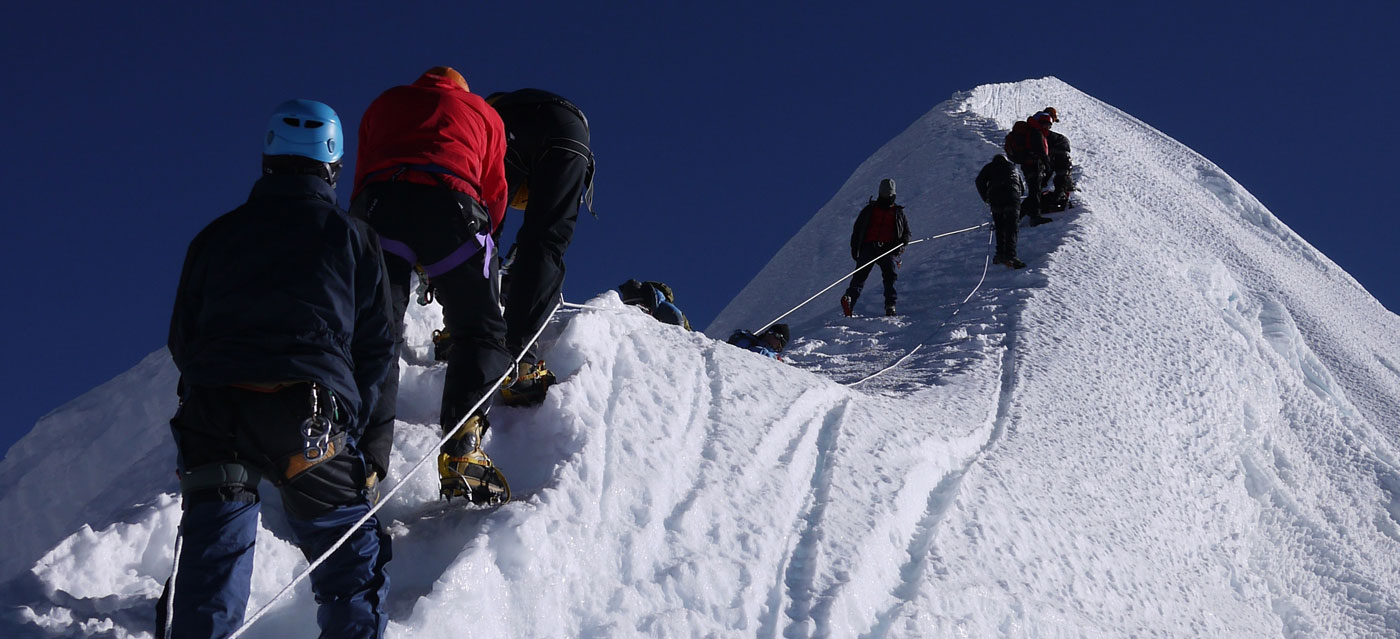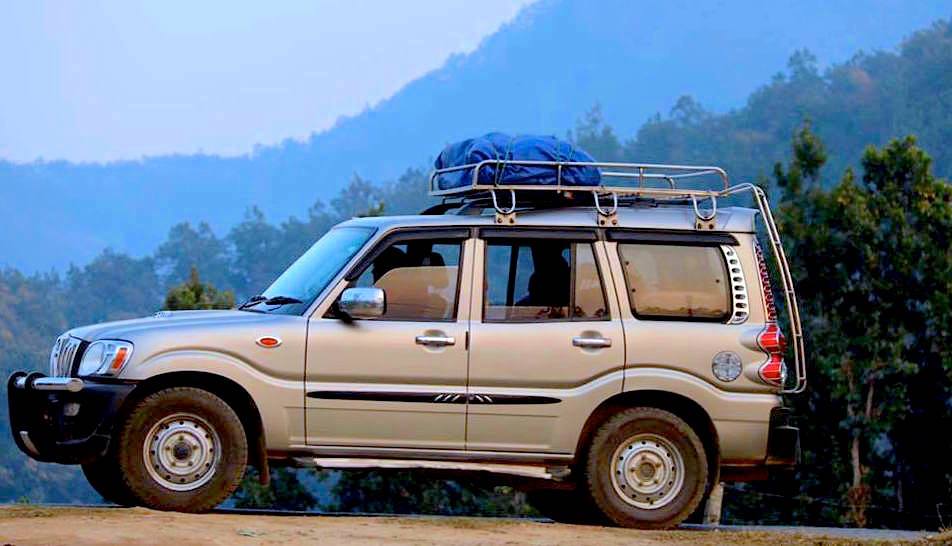Please Note: Your safety is of the utmost concern whilst you are travelling with Rising Himalaya Trek. We will make every effort possible to follow the original itinerary but we reserve the right to change that itinerary if a segment of it becomes a safety issue. Certain mountain regions are remote, natural disasters can happen, weather conditions can decline and there can be illness or an injury. To avoid dangerous situations we may occasionally have to make changes to the itinerary to ensure everyone's safety. That having been said, Adventure Club Trek will strive to provide you with the best possible trekking experience and to keep your safety our number one priority. In case, the flight delay/cancellation happens at the start of trip and it goes so long that it disturbs your onward travel schedule, you are free to choose an alternative trip: such a trek in the Annapurna, Langtang, Everest or any Other Regions.
Trekking group
Our standard trekking groups usually comprise of a maximum 20 people. This number of people generally works well. Trekkers will be living in the wilderness and need to be able to interact with and support each other. Your fellow trekkers will be like-minded in their goals but will obviously have different personalities. As much as possible we strive to ensure trekkers get along with each other and have as much fun as possible. For private group treks we have no minimum or maximum group sizes.
Pre-Trip Meeting
Prior to all our treks and expeditions, we host a Pre-Trip meeting in Kathmandu. The primary purpose of meeting is to provide an opportunity for individuals to ask questions about the forthcoming trek and to introduce them to other team members. The meeting covers topics as diverse as personal equipment and acclimatisation and usually involves a hike and some skills training. We believe that pre-trip meeting is very important in order to better preparation of the trekking.
Meals and safe drinking water:
Drinking water: Drinking water from taps can be risky business. Hotels and lodges usually make available safe water in a thermos flask in guest rooms. Bottled mineral water is available almost everywhere from hotels to grocery shops. If you are moving in rural areas, carry iodine tablets with you; it's the best thing to do. Drinking water containing iodine tablets will thoroughly protect you from viruses, bacteria and parasites. Iodine crystals are also available from local outlets at a fairly reasonable price; it's also important to note that Iodine can produce laxative reactions on your body if taken beyond reasonable limits.
When on the trail, our staff will boil and cook meals treated by potassium permanganate or iodine. When doing an independent GAP trek, you will be able to buy safe hot drinks & water in the teahouses on your trail routes. We highly recommend that you carry water purification pills because prevention is always better than cure. When hiking out in the open wild, bear in mind that water from the streams is safe if away from settlements.
Meals: On the Teahouse Treks: We provide routine western breakfast, lunch and a three course dinner, & tea or coffee will also be included with each meal. Your guide will consult with the group for a menu selection that meets everyone's choice. The aim is to ensure that you get the best meals possible keeping in mind your dietary needs under harsh conditions. The food is pretty high in quantity but the menu is limited with not many choices. Most teahouses offer a variety of rice and noodle dishes, as well as soup and seasonal vegetables. A variety of cereals, bread and egg dishes are generally on the table for breakfast. Snacks are generally full & plenty with cookies, chocolates & soft beverages plenty; you may also come across fresh fruit in season. You can buy packaged water (bottled mineral water) from local lodges and shops en route but be sure that you check the expiry date of the water bottle; you can also ask your guide to fill your water bottle with boiled water and treated with water purification pills. Its important to note that your breakfast & dinner is generally always served at the teahouse you bunk out in, but lunch is prepared on the trail amidst the sweet chirping of birds on the look out for a change in diet…
On the Camping Treks: We provide three delicious, fullsome and nutritious meals daily with an assortment of local and western dishes. Your day begins with a king-size breakfast that includes a choice of porridge, muesli and cereal followed by omelet, fried or scrambled eggs with chapattis or bread. Lunch is generally a selection of salad, cooked vegetable dishes, pasta and traditional breads. Dinner is a warm & gratifying 3 course meal of soup, followed by a variety of vegetables, meat, rice and pasta dishes that are rounded of with a simple dessert. Tea, coffee and hot chocolate are also provided with all meals. We make it mandatory to use as much fresh produce as possible and special diets are regularly catered for. The trek leaders keep a very tight lid on general cleanliness & supervise in the kitchen with respect to general cleanliness ensuring that all food preparation is done in accordance with all personal hygiene.
All foods are well cooked and vegetables are treated by potassium permanganate or iodine. Boiled water is served for drinking. Antiseptic soaps and potassium or iodine treated water are provided for washing. Special dietary requirements can always be catered for.
Accommodation:
Accommodation in City: At the Rising Himalaya, for all our fixed departure trips, 2-3 nights' accommodation is arranged at a conveniently located 3-4 star hotel in Kathmandu. If you already have your own hotel booked in advance in Kathmandu, there will be some reduction on our costs. We have specially negotiated rates for a range of hotels; we are in a position to offer the best deals to suit your budget and preferences. No matter what level of hotel you need, we always ensure that you get the best accommodation that matches your general comforts at all times. Please check our 'HOTEL BOOKER' section of our website for price and availability.
Teahouse Lodge: While we always endeavor to provide the best possible accommodation when on the trail, you should be aware that most teahouses, particularly in the smaller villages, are pretty basic. The bedrooms are usually very small, & the shared bathroom facilities are often outside and meals are served in a communal dining hall. Although structured in mountains & simple, the teahouses do provide shelter and are cosy to bunk out in; these teahouses are normally run by friendly local families & are less expensive then Camping treks and are largely suitable for small groups. Usually during the peak seasons if private rooms in smaller villages are fully occupied you might have to crash out in a dormitory.
Camping: For camping treks we always provide comfortable two men camping tents, foam mattress, & 4 season sleeping bags. We always make sure that basic comforts are available no matter how harsh terrain conditions may be at whatever altitude levels. Be it teahouse lodges or camping, the spirit of adventure is always there & this spirit guides us on the
Trekking Leader(s) & caring for Porters:
Trekking Leaders: The success of your Trek is the leader's most imperative task. Our team leaders and crew are highly skilled and experienced for the region you are traveling in. Adventure Club uses local staff where possible to help sustain their families & communities.
Each leader has an integral range of experience and ability in the environment and ecosystems, with the local geography and history and the flora and fauna of the area. All of our Leaders speak English and can handle fundamental medical issues with the knowledge of how to deal with different levels of emergencies. Your safety is mandatory to their concerns. Our trek leaders are people who have braved the wild on some of the toughest terrain on earth…
Porters care: Porters are a central part of our journeys into the wild & is also behind our values and style of travel. We go the extra mile to take our travellers off-the-beaten track, avoiding the clogged trails, to experience our high & wild tent-based adventures … this style of trekking can only be made possible by our porters. Porters mean the same to us as those who trek with us; they are human beings like everybody else. Without them, it's virtually impossible to run our class programs in the wild. When we trek, the entire group - travellers, guides and porters alike - are a team who share the same needs for safety in harsh mountain environments. For this reason, all our porters are provided the best equipments & clothing available. We make doubly sure all our porters are well treated & well paid, & providing insurance for their future protection. Porters who get sick are treated with the same care and attention as other team members and we have even gone all the way in hiring helicopters - at our expense - to rescue porters from hazardous situations. We always request that trekkers respect their contribution to the success of your expedition and ask you to keep your personal baggage weight under 15kgs/30pounds.
Acclimatization:
Acute Mountain Sickness, known as AMS, is a risk in high altitude trekking. Accordingly our staff members are trained in this area and every trek is planned with this risk taken into consideration. Ascending mountains too fast causes AMS and this condition is serious enough to kill some people. Less oxygen is available at high altitudes and each person's body has to adjust to this individually. The best way to prepare for the decrease in oxygen is to allow time for acclimatization and this can take several days. To decrease the risk of AMS there needs to be sensible planning. If you have heart, lung or blood conditions you are strongly advised to consult your doctor prior to making your travel plan. Symptoms of AMS can be mild headaches, dizziness, fatigue, and shortness of breath, nausea and a general feeling of malaise. As the condition worsens it can bring on decreased co-ordination, increasing weakness and an inability to walk. For more information please refer to "High Altitude: Acclimatization and Illnesses" by Rick Curtis, see http://www.princeton.edu/~oa/safety/altitude.html. Our itineraries are designed to try to prevent AMS but it is important to remember that some people are more vulnerable to AMS than others.
Below are some rules of acclimatization:
- increase altitude gradually
- consume lots of liquids
- avoid alcohol, smoking and using sleeping tablets
- use preventive medicines
- Acetazolamide or Diamox®
- Ginkgo biloba extract
- Garlic soup
- avoid overexertion
- don't go trekking alone
- don't climb higher even if you are only suffering from mild symptoms of altitude sickness
- descend immediately if your altitude sickness symptoms get worse
- never leave anybody alone with signs of altitude sickness
- dress warmly when trekking
To make sure that you return from trekking in the Himalayas in Nepal with a lot of happy and unforgettable memories, it is vital that you're aware of the altitude acclimatization required by the human body in mountain conditions.
Travel insurance
Adequate travel insurance is an absolute must when you are trekking. Hiking in the Himalayas is relatively safe but the unexpected can always occur. If you need to be rescued then the price may be exceedingly high, especially if it is a helicopter evacuation. If this happens to you then you will need to supply proof, upfront, that you can pay for your evacuation. Standard travel insurance is simply not sufficient. Please ensure your travel insurance company understands that you will be mountaineering. Your policy should cover all of the following: death, injury, helicopter evacuation from remote areas, trip cancellation, theft of baggage, loss of baggage and liability.
Your health and fitness
For a successful hike you need to be healthy and fit. You need to consult your doctor before making your holiday plans. He or she can then advise if your health will compromise your ability to enjoy strenuous mountaineering activity. Your doctor then needs to issue you with a certificate of fitness prior to your booking being accepted. You will also need to check with your doctor or a travel clinic to find out what vaccinations are needed. Fitness is paramount but you don't need any specific technical hiking experience. It is important to arrive with a determined mental attitude and a positive, can-do outlook. We endeavour to ensure the greatest standard of food hygiene on our treks and we carry comprehensive medical kits. Our trekking guides and our Sherpa helpers are all experienced in first aid and if anyone becomes seriously ill there is the option of helicopter evacuation.
Our Himalayan experience
If you are searching for a top-class mountaineering experience with no hidden or extra expenses then Rising Himalaya Trek is your obvious choice.
Our company has been operating adventure travel holidays in the Himalayas since 2002. We offer expeditions in Nepal, Bhutan, Tibet and the Indian Himalayas. We have an extensive network of experienced staff and quality ground services such that we are able to ensure you receive a top quality travel experience that you will remember forever. We use responsible, local tour leaders who are all highly experienced staff.
We have hundreds of itineraries ranging from strenuous hiking to the more laid back, walking, cultural holidays. We have many scheduled departure dates throughout the year. We can supply holidays guaranteed to suit everyone.
What to expect
Providing you prepare yourself mentally and physically you stand an excellent chance of thoroughly enjoying your adventure holiday in the Himalayas. Our philosophy is that the whole journey should be just as enjoyable as reaching the final destination. In order to maximize your enjoyment you need to have an understanding of what to expect on your journey.
Each day in the Himalayas will involve four to seven hours of trekking. You will climb to levels as high as 5550 metres/18204 feet. Climbing at such heights requires optimum aerobic fitness so that you are less inclined to experience altitude sickness. You will reach heights where the air is a much as 50% thinner than it is at ground level so you will benefit enormously if you have optimized your aerobic fitness before arrival. We encourage you, before leaving home, to practice hiking for two hours each day with ever increasing weights on your back. It is important to perform exercise that gets your heart pumping. You should try running or cycling for sustained periods of time to improve your aerobic fitness. Increased physical fitness will give you the stamina needed to complete your quest.
You also need to prepare yourself mentally for your trekking holiday. You will exist in the wildnerness for several days with a group of people with varying personalities. You will have both ups and downs on your adventure holiday and you will need to embrace all experiences, including any less pleasant ones you might not have hoped to happen. By always thinking positively you will overcome any minor inconveniences. Despite all precautions taken by our company there are sometimes unexpected mishaps. Generally these mishaps are minor and your positive attitude will increase your enjoyment of the trip and sustain your wonderful memories of the Himalayas.











